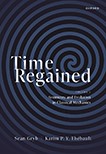 Time Regained: Volume 1: Symmetry and Evolution in Classical Mechanics
Time Regained: Volume 1: Symmetry and Evolution in Classical Mechanics
Contents
Part front matter for Part I NATURAL PHILOSOPHY OF TIME
Get access-
Published:November 2023
Cite
Extract
In Part I we will consider the natural philosophical analysis of time according to Newton, Leibniz, and Mach. We will do this with a view to deepening our understanding of the conceptually complexity of time in mechanical theory. Our Principial aim throughout will be to isolate the challenge of disambiguating a unique quantitative representation of time within a Newtonian universe. It is for this reason that we choose to focus on the view of time espoused by Newton himself, and the two critics, Leibniz and Mach, whose influence is most conspicuous in modern critical discussions of the Newtonian natural philosophy of time.
We begin our analysis with consideration of the absolute conception of time defended by Isaac Newton in the famous Scholium section that follows the eight opening definitions of the Principia (hereafter simply referred to as the Scholium). Discussion of the proper definition of uniform motion pre-dates Newton to some considerable degree (Barbour, 2001; Gaukroger, 2006). However, what can plausibly be taken to be original to Newton is the forging of a close connection between the problem of defining uniform motion and a particular absolute conception of time within a quantitative system of mechanics.1
Sign in
Personal account
- Sign in with email/username & password
- Get email alerts
- Save searches
- Purchase content
- Activate your purchase/trial code
- Add your ORCID iD
Purchase
Our books are available by subscription or purchase to libraries and institutions.
Purchasing information| Month: | Total Views: |
|---|---|
| February 2024 | 2 |
| May 2024 | 2 |
| August 2024 | 1 |
| November 2024 | 1 |
| December 2024 | 2 |
Get help with access
Institutional access
Access to content on Oxford Academic is often provided through institutional subscriptions and purchases. If you are a member of an institution with an active account, you may be able to access content in one of the following ways:
IP based access
Typically, access is provided across an institutional network to a range of IP addresses. This authentication occurs automatically, and it is not possible to sign out of an IP authenticated account.
Sign in through your institution
Choose this option to get remote access when outside your institution. Shibboleth/Open Athens technology is used to provide single sign-on between your institution’s website and Oxford Academic.
If your institution is not listed or you cannot sign in to your institution’s website, please contact your librarian or administrator.
Sign in with a library card
Enter your library card number to sign in. If you cannot sign in, please contact your librarian.
Society Members
Society member access to a journal is achieved in one of the following ways:
Sign in through society site
Many societies offer single sign-on between the society website and Oxford Academic. If you see ‘Sign in through society site’ in the sign in pane within a journal:
If you do not have a society account or have forgotten your username or password, please contact your society.
Sign in using a personal account
Some societies use Oxford Academic personal accounts to provide access to their members. See below.
Personal account
A personal account can be used to get email alerts, save searches, purchase content, and activate subscriptions.
Some societies use Oxford Academic personal accounts to provide access to their members.
Viewing your signed in accounts
Click the account icon in the top right to:
Signed in but can't access content
Oxford Academic is home to a wide variety of products. The institutional subscription may not cover the content that you are trying to access. If you believe you should have access to that content, please contact your librarian.
Institutional account management
For librarians and administrators, your personal account also provides access to institutional account management. Here you will find options to view and activate subscriptions, manage institutional settings and access options, access usage statistics, and more.